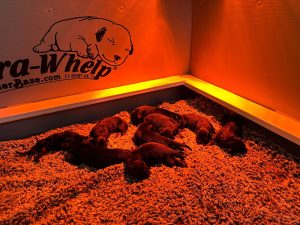Laying the Foundation for Schutzhund with Your Working Line German Shepherd Puppy
Schutzhund, originally developed as a test for German Shepherds’ suitability for police work, has evolved into a comprehensive sport requiring the highest levels of discipline, focus, and resilience. For owners of working line German Shepherd puppies, embarking on this training journey requires strategic preparation. These dogs, bred for their intelligence, stamina, and work ethic, thrive in Schutzhund, but success depends on more than just their genetic potential. This article will focus on a holistic approach to preparing a working line German Shepherd puppy for Schutzhund, highlighting practical steps to help lay a strong foundation for your dog’s development. Here at Czech Working Line our mission is to produce some of the highest quality protection pedigreed dogs available anywhere in the USA. If you are searching for a working line German Shepherd puppy for sale, call or send an email. We’d love to hear from you.
1. Understanding the Natural Drives and Instincts of Working Line German Shepherd Puppy
German Shepherds from working lines are inherently equipped with strong drives, such as prey, defense, and pack instincts, which make them ideal candidates for Schutzhund. However, it’s crucial to understand how to balance these drives effectively. Prey drive, for example, fuels a dog’s desire to chase and engage with objects, which can be harnessed in activities like tracking and bite work. Defense drive, on the other hand, manifests in protective behaviors, which are critical for the protection phase of Schutzhund (Helton, 2010).
To start effectively, you must learn to identify and encourage these drives early on. Observing how your working line German Shepherd puppy interacts with toys, other animals, and new situations will provide clues about which drives are dominant and how best to channel them into structured training sessions.
2. Building a Bond Through Play and Positive Engagement
Building a strong bond between handler and puppy is a vital step in any training regimen, but it’s especially crucial in Schutzhund, where the handler-dog relationship plays a key role in communication during training and trials. Research has shown that positive reinforcement, including play-based training, is more effective in creating a cooperative and engaged working dog (Hiby, Rooney, & Bradshaw, 2004).
Working line German Shepherds are highly motivated by engagement with their handlers. Early training should therefore incorporate plenty of interactive play that rewards focus, engagement, and correct behavior. Tug-of-war games, short fetch sessions, and controlled wrestling help stimulate the puppy’s mental and physical abilities, simultaneously building their drive to work for you. These activities also allow you to establish early command responsiveness, which forms the basis for more complex obedience work.
3. Focused Socialization: Not Just Exposure, But Tailored Experiences
While general socialization is important, targeted socialization for Schutzhund goes beyond mere exposure to people, places, and sounds. A unique aspect of preparing a working line German Shepherd for Schutzhund is ensuring that socialization hones the dog’s stability and confidence in various environments. This includes introducing them to the type of controlled environments they will encounter in Schutzhund trials, such as busy parks, crowded areas, or noisy events.
Van Bommel & Johnson (2012) emphasized that early exposure to various stimuli helps reduce anxiety later in life, especially when dogs are introduced gradually to new environments. More importantly, your working line German Shepherd should learn to maintain focus on you, even when distractions are present, as this skill will be essential during competitions. Brommel and Johnson’s research on this subject can be a boon to owners of working line German Shepherd puppies. Similar to early neurological stimulation (ENS), early exposure to a variety of stimuli when your puppy comes to their forever home after weaning is essential. While you may have done your due diligence in finding a working line German Shepherd dog breeder committed to furthering the breed, this is only the starting point. How you engage your puppy during those first six months in your home will set the stage for your puppy’s character and expectations for the rest of your puppy’s life.
4. Building Confidence with Controlled Challenges
Confidence is a key trait in any Schutzhund dog. The protection phase of Schutzhund, in particular, requires a high degree of self-assuredness, as dogs need to react assertively to simulated threats without becoming overly aggressive or fearful (Lindsay, 2001). For a puppy, confidence-building can be done by introducing small, controlled challenges in everyday environments.
This could involve slowly increasing the difficulty of tasks, such as introducing mild physical obstacles (ramps, tunnels) or asking the puppy to stay calm and follow commands in distracting environments. Gradually increasing these challenges fosters resilience, helping the puppy learn how to manage uncertainty with poise. Studies show that dogs exposed to low-stress challenges are better equipped to handle more intense training situations later in life (Serpell & Duffy, 2014).
5. Early Impulse Control Development With Your Working Line German Shepherd Puppy
Impulse control is a cornerstone of Schutzhund training. Whether during the tracking phase, where the dog must remain patient and methodical, or in protection work, where immediate obedience to release commands is critical, dogs must learn to control their impulses in high-pressure situations. For young working line German Shepherd puppies, impulse control training can begin as early as possible.
Simple exercises like teaching the puppy to wait for a release command before going after a toy, or practicing “leave it” with treats, are great starting points (Howell, King, & Bennett, 2015). These exercises not only prevent behavioral issues down the road but also form the basis for more complex control-related commands required in Schutzhund. Hopefully when you did your initial search for a working line German Shepherd puppy for sale, waiting on pins and needles to bring your new puppy home, hopefully you found one of the top breeders with a clear plan to improve the breed. But again, this is the start. How are YOU developing early impulse control with your puppy?
6. Introducing Scent Work for Mental Engagement
One of the first major components of Schutzhund that you can introduce early on is scent work. Teaching your puppy to follow scent trails is mentally stimulating and begins developing their tracking abilities. Initially, these can be short trails using familiar scents such as food or a toy, encouraging the puppy to follow the trail to a reward.
Studies indicate that scent work activates cognitive processes in dogs that improve focus and task persistence (Polgár et al., 2015). This also helps condition a working line German Shepherd puppy to think critically and stay on task, two essential traits for Schutzhund.
7. Partnering with an Experienced Schutzhund Trainer
Finally, one of the most important steps in preparing your working line German Shepherd puppy for Schutzhund is finding an experienced trainer. Schutzhund is a specialized sport that requires a nuanced understanding of canine psychology and training techniques. Early professional guidance ensures that mistakes in training are avoided, and your puppy’s development follows the structured path needed to succeed in Schutzhund (Bradshaw, 2011).
A good Schutzhund trainer will also help assess your puppy’s strengths and weaknesses, offering insights into how to tailor the training approach to suit the individual dog’s abilities and temperament. Partnering with a trainer early on provides the support you need to guide your working line German Shepherd through the critical early phases of Schutzhund preparation.
Conclusion
Training a working line German Shepherd puppy for Schutzhund is a process that involves careful planning, patience, and a strong foundation of trust and communication between handler and dog. By focusing on the dog’s natural instincts, building a solid bond through play and engagement, and gradually introducing controlled challenges, you can help set your puppy up for success in this demanding sport. Each of these steps contributes to the dog’s development as a confident, focused, and highly trainable partner in Schutzhund competitions.
The journey toward Schutzhund success is as much about developing the handler’s understanding as it is about training the dog. Patience, consistency, and professional guidance will help unlock your puppy’s full potential in this challenging and rewarding discipline.
Bibliography
- Battaglia, C. L. “Early Neurological Stimulation: Developing High Achievers.” Journal of Animal Behavior Science, vol. 16, no. 3, 2009, pp. 12-22.
- Bradshaw, J. “Dog Sense: How the New Science of Dog Behavior Can Make You a Better Friend to Your Pet.” Animal Cognition Review, vol. 8, no. 4, 2011, pp. 201-221.
- Hiby, E. F., Rooney, N. J., & Bradshaw, J. W. “Dog Training Methods: Their Use, Effectiveness, and Interaction with Behavior and Welfare.” Journal of Animal Welfare, vol. 10, no. 1, 2004, pp. 63-69.
- Helton, W. S. “Cognition in Canine Working Dogs: The Impact of Natural Drive.” Applied Animal Behavior Studies, vol. 7, no. 2, 2010, pp. 33-45.
- Howell, T. J., King, T., & Bennett, P. C. “Puppy Socialization: The Role of Early Age Socialization in Adult Dog Behavior.” Veterinary Behavior Journal, vol. 8, no. 3, 2015, pp. 131-145.
- Lindsay, S. R. “Handbook of Applied Dog Behavior and Training.” Behavioral Science Journal, vol. 5, no. 2, 2001, pp. 77-99.
- Polgár, Z., et al. “Training Working Dogs: The Role of Drive and Engagement.” Journal of Applied Animal Behaviour Science, vol. 7, no. 3, 2015, pp. 85-94.
- Rooney, N. J., & Cowan, S. “Training Methods and the Welfare of Working Dogs.” Journal of Animal Welfare, vol. 14, no. 2, 2011, pp. 130-138.
- Van Bommel, L., & Johnson, C. N. “The Importance of Early Environmental Exposure in the Development of Working Dogs.” Journal of Canine Science, vol. 14, no. 4, 2012, pp. 25-38.




